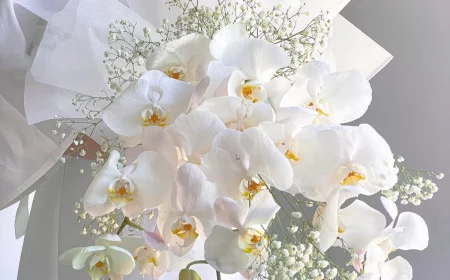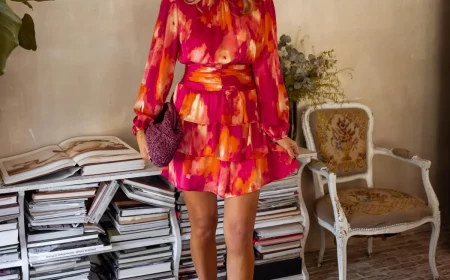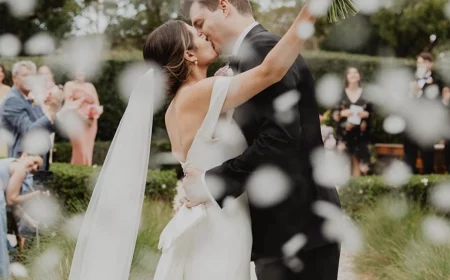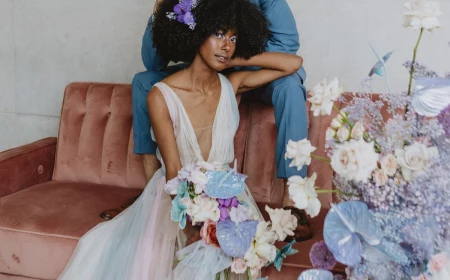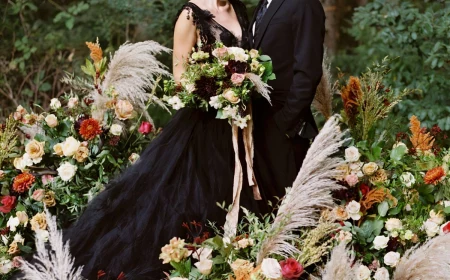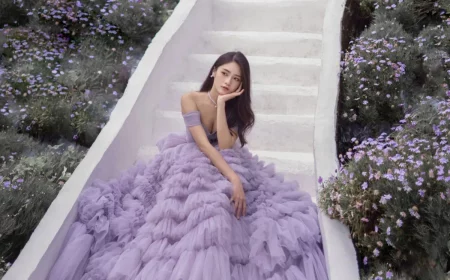My Unfiltered Guide to Buying Your Wedding Dress Online (Without Crying Later)
I’ve spent more years than I can count in the world of weddings. I’ve been in bustling city fitting rooms and the quiet, creative studios of independent designers. I know the delicate feel of Chantilly lace and the distinct, satisfying rustle of rich Mikado silk. But more importantly, I’ve seen that incredible flash of joy on a bride’s face when she finds the dress. And honestly? I’ve also seen the tears when a dress, ordered online with so much hope, shows up looking like a cheap, sad imitation of the photo.
In this article
Let’s be real: buying your wedding dress online can be a fantastic, modern choice. It opens up a universe of styles you’d never find in local shops. But it’s not like buying a sweater on Amazon. It takes a solid plan, a sharp eye, and a healthy dose of realism.
So, I want to give you the exact same advice I’d give a close friend. This isn’t about finding a bargain-basement dress; it’s about finding a gorgeous, well-made gown for a fair price—and skipping all the common scams and pitfalls. This is my tried-and-true method for getting it right.
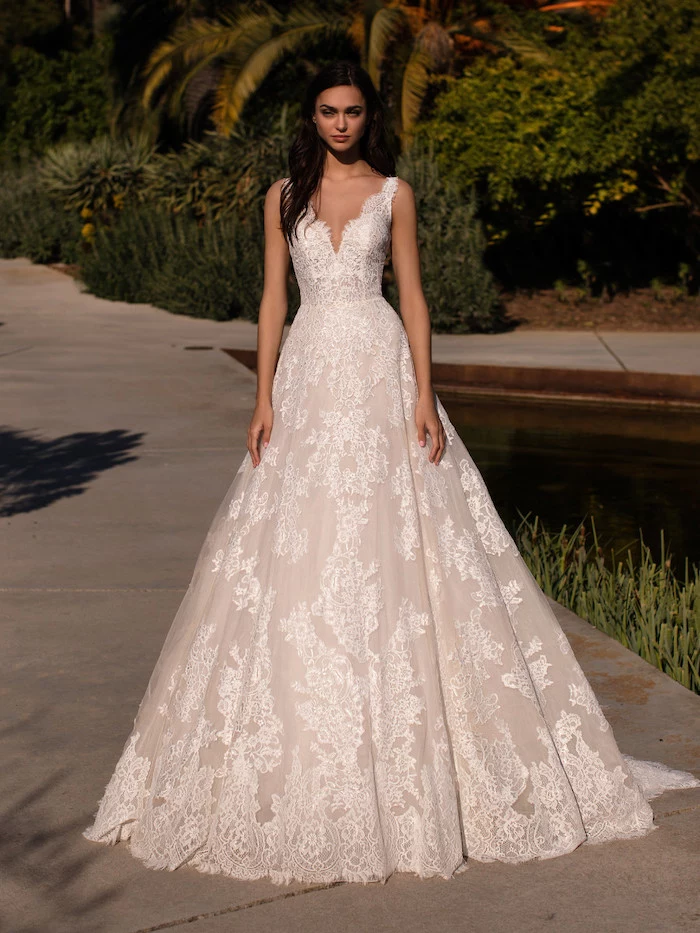
Part 1: The Prep Work (Before You Even Think About Browsing)
The single biggest mistake I see is starting the fun part—the searching—way too early. A successful online dress purchase starts with prep, not a search engine. Before you type a single thing into Google, you need what I call a “Bridal Blueprint.”
Think of it as your non-negotiable guide. It’s a simple document with all your critical info in one place to keep you focused and prevent some seriously expensive mistakes.
Crafting Your Bridal Blueprint
1. Your Precise Measurements
Heads up! Bridal sizing is its own strange beast and has nothing to do with the size you wear in jeans. It’s a standardized system that designers use, and it hasn’t been updated with vanity sizing. A bridal size 12 is often a street size 8 or 10. You have to ignore the number on the tag and focus only on your measurements.
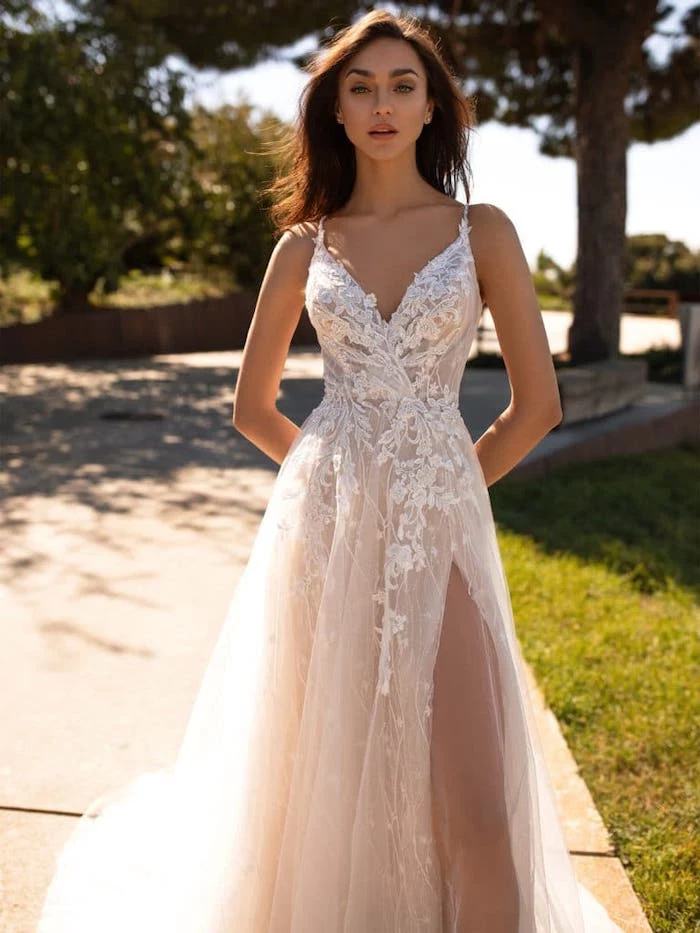
You’ll need a soft measuring tape and a friend. You absolutely cannot take these accurately by yourself, I promise. Wear something form-fitting, like leggings and a tank top, and the kind of undergarments you plan to wear on the big day. Measure these three spots:
- Bust: Go around the fullest part of your chest. Keep the tape level with the floor.
- Waist: Find the narrowest part of your natural waist. It’s usually about an inch above your belly button. No sucking in!
- Hips: Measure around the absolute fullest part of your hips and butt.
There’s also a fourth measurement the pros use: “hollow to hem.” This is for the length. Stand up straight, feet together, and have your friend measure from the hollow part at the base of your neck straight down to where you want the dress to end. Oh, and do this while wearing the shoes (or a pair with the same heel height) you plan to wear for the wedding.
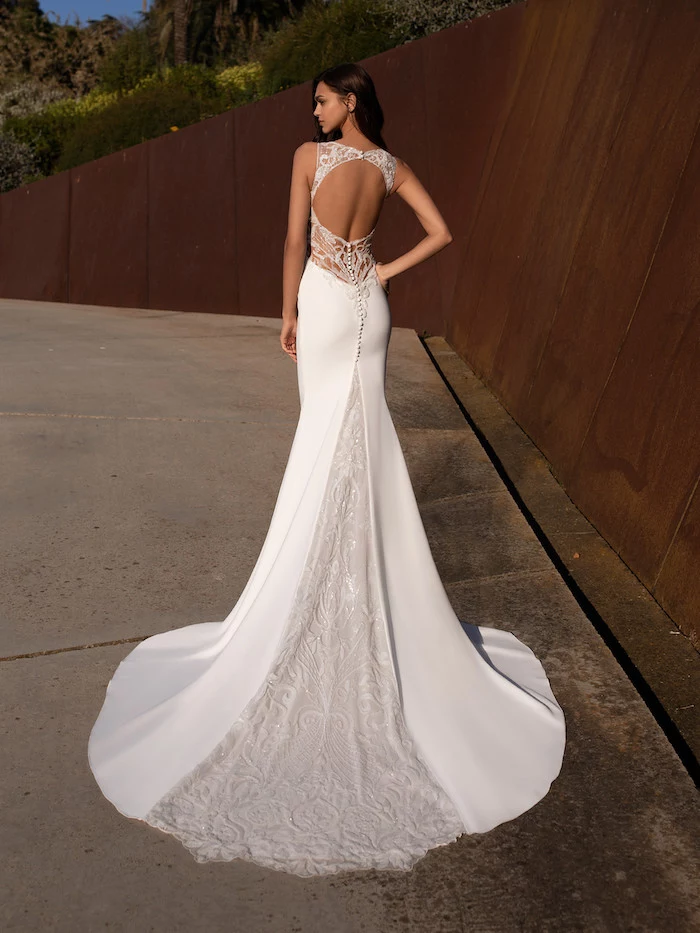
2. Your Realistic, All-In Budget
This is where so many people get into trouble. The price on the website is just the beginning. Your total dress budget must include:
- The price of the dress itself.
- A fund for alterations. I always tell my clients to budget at least 15-25% of the dress cost for this. For a $2,000 dress, that’s an extra $300 to $500. It can be way more for complex work like resizing intricate beadwork.
- Shipping costs, taxes, and potential customs fees if you’re buying from another country.
A $1,500 dress that needs $600 in alterations is really a $2,100 dress. Being brutally honest with yourself about this total number from the start will save you a lot of stress later on.
Quick Tip: Before you even start looking at dresses, find one or two highly-rated local seamstresses. Call them up and ask for a ballpark quote on common alterations, like a hem or taking in a bodice. A five-minute phone call makes your budget real and helps you find a trusted pro before you’re in a time crunch.
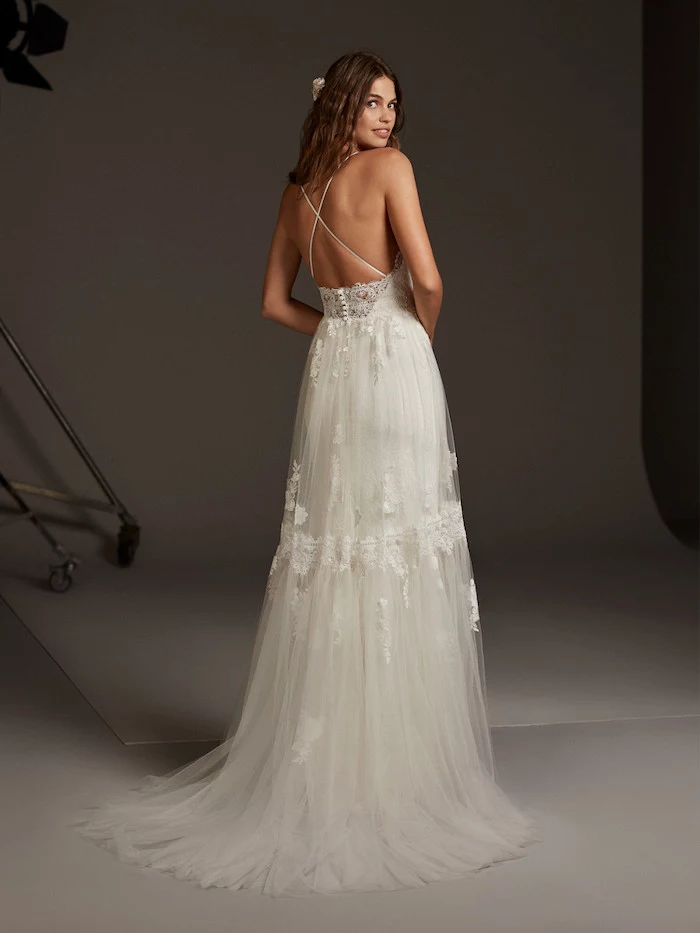
3. Your Wedding Timeline
Timing is everything. A made-to-order dress, even from an online shop, takes a while. Rushing is a recipe for mistakes and extra fees. Here’s a timeline that gives you some breathing room:
- 10-12 months out: Start your research and finalize your Bridal Blueprint.
- 8-10 months out: Place your final order. This usually allows 4-6 months for the dress to be made and shipped.
- 3-4 months out: Your dress should arrive. Inspect it IMMEDIATELY. Don’t let it sit in the box for a week. Check every seam for flaws, compare it to the listing photos, and contact the seller right away if something is wrong.
- 1-2 months out: Your first and final fittings with the seamstress.
- 2 weeks out: Pick up your perfectly altered dress.
Trust me, that buffer room is a lifesaver. I’ve seen customs delays and production snags eat up weeks of time.
Your Bridal Blueprint Checklist (Copy & Paste This!)
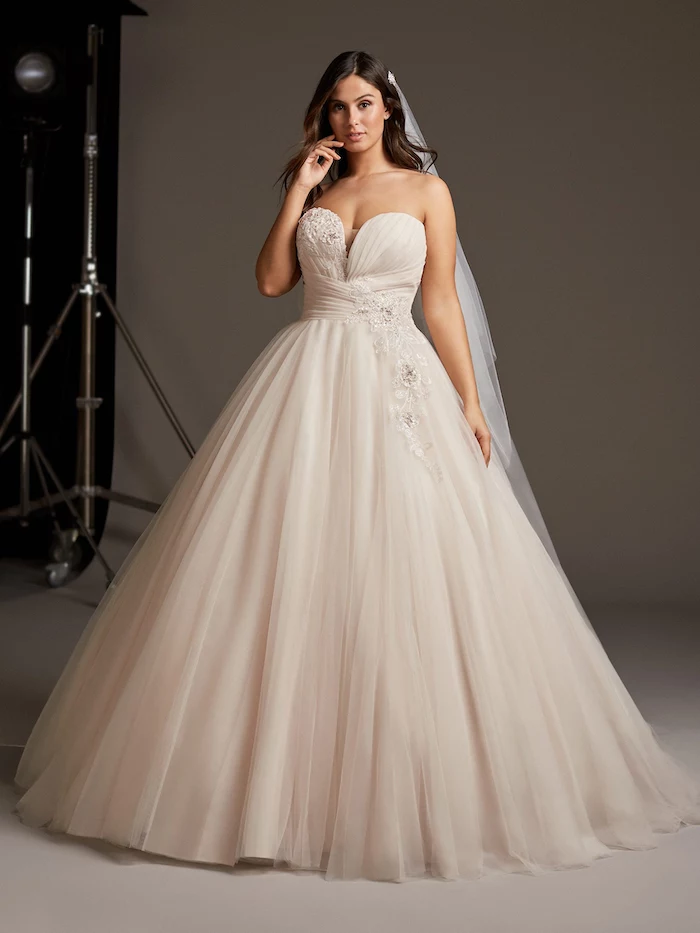
- Bust Measurement: ____
- Waist Measurement: ____
- Hip Measurement: ____
- Hollow-to-Hem Measurement: ____
- Total Budget (Dress + Alterations + Fees): $____
- Key Timeline Dates (Order by, First Fitting, etc.): ____
Part 2: How to Vet an Online Seller (And Avoid Scams)
Okay, so you have your blueprint. Now, where do you actually look? And how do you know who to trust? This is arguably the most important part.
Where to Start Your Search
Instead of just a blind search, start with places that have a reputation to protect. Here are a few different tiers of online sellers:
- Established Online Retailers: Think of sites like BHLDN (Anthropologie’s wedding brand) or the online stores for well-known bridal lines. They have customer service, clear return policies, and a proven track record. This is the safest, but not always the cheapest, route.
- Indie Designer Marketplaces: Etsy is the big one here. You can find stunning, unique dresses from small designers all over the world. The key is to vet the individual seller very, very carefully (more on that below).
- Pre-Owned and Sample Sale Sites: Websites like Still White or Nearly Newlywed are fantastic for getting a designer dress at a major discount. You’re buying from another bride, so there are no returns. You have to be 100% sure of your measurements and the dress condition.
Your Built-In Scam Detector
When you’re looking at a dress from a lesser-known seller, put on your detective hat. Here are the red flags:
- The Photos Look Too Perfect. Are all the photos professional model shots from a magazine? That’s a potential red flag. Scammers often steal photos from high-end designers. What you want to see are photos of the dress on real customers or on a mannequin in the seller’s studio. Pro tip: Right-click an image and choose “Search Image with Google.” If it shows up on a bunch of other sketchy-looking sites or belongs to a famous designer, run away.
- Vague or Non-Existent Return Policy. A legitimate business will have a clear, easy-to-find policy. If you can’t find it, or if it just says “no returns, no exceptions,” be very wary.
- No Customer Photos in the Reviews. 5-star reviews are great, but they’re easy to fake. The gold standard is a review that includes a photo from a real bride’s wedding day. That’s proof they actually delivered a quality product.
- The Price Is Unbelievably Low. If you see a dress that looks like a $5,000 gown being sold for $250, it’s not your lucky day. It’s a knock-off, and it will be made of cheap materials that look nothing like the picture.
Part 3: Becoming a Fabric Expert Through Your Screen
When you’re shopping online, you can’t touch the dress, so you have to learn to “feel” it with your eyes and your brain. Understanding fabrics is your superpower. A good seller will proudly share the specifics; a bad one will be vague.
Before you commit, ALWAYS order fabric swatches. Seriously. It might cost you $20 or $30, but it is the ONLY way to feel the true weight, see the exact color in different lights, and know what you’re really paying for. It’s the best money you’ll spend in this whole process.
A Quick Fabric Guide
Fabric determines how a dress falls, feels, and photographs. Here’s a quick rundown:
- For Structure & Drama (Ball Gowns, A-Lines): Go for something like Mikado or Satin. Mikado is a luxurious, heavier blend that creates clean, architectural lines with a soft sheen; it’s formal and has a low wrinkle-factor but can be warm. Duchess Satin is similar—stiff, formal, and elegant. Taffeta is another great choice; it’s crisp, smooth, and makes a slight rustling sound, but it does tend to wrinkle more easily.
- For Softness & Flow (Boho, Beachy, Ethereal): Look for Chiffon or Organza. Chiffon is matte, sheer, and light-as-air, making it perfect for draping and for destination weddings. Organza is a bit crisper and more structured than chiffon but still lightweight and dreamy. Both are delicate, so be careful of snags.
- For Figure-Hugging & Modern Styles (Mermaid, Sheath):Crepe is your best friend. It’s a smooth, elegant fabric with a beautiful drape that lightly hugs the body. It’s chic and sophisticated but also shows everything, so good undergarments are a must. Charmeuse is a slinky, liquid-like satin that also drapes beautifully but is less forgiving.
Buying your dress online doesn’t have to be a gamble. In fact, armed with the right information, it can be an incredibly rewarding and modern way to find the gown of your dreams.
So, take a deep breath. Do your homework first, trust your gut, and focus on the details. You’ve got this.
Inspirational Gallery
More than 75% of brides make alterations to their dress, with costs often ranging from $200 to over $1,000.
When ordering online, this is not a hidden fee—it’s a planned expense. Budget for a great local seamstress from the start. They can fix minor fit issues, add a bustle for your train, and truly customize the gown to your body. Ask for recommendations in local bride groups; a trusted tailor is worth their weight in gold.
What’s the real difference between
The Fabric Test: What Works Best When Buying Sight-Unseen
Structured Fabrics (like Mikado or Taffeta): These photograph beautifully and hold their shape well, minimizing the appearance of wrinkles from shipping. Their structure is less likely to cling, making sizing slightly more forgiving.
Flowy Fabrics (like Chiffon or Organza): Ethereal and romantic, but they can arrive creased. Ensure you have access to a professional steamer (not an iron!). Their drape is beautiful but can also highlight areas you’d rather not.
For online purchases, structured fabrics often deliver a more predictable result straight out of the box.
Don’t just look at the model photos; hunt for the tagged pictures. On Instagram, search for the dress by its specific name (e.g.,
- Create a luxe, private atmosphere with candles and music.
- Have your key accessories—shoes, any special jewelry—ready to try on.
- Set up a video call for loved ones who can’t be there.
- Pop a bottle of champagne to celebrate the moment!
The secret? Recreating the ‘Say Yes’ moment at home. The boutique experience isn’t about the fancy sofa; it’s about the feeling. Make your at-home try-on a genuine celebration rather than just a quick fitting.
Watch out for import duties and taxes! If you’re ordering from an international designer (a common scenario with unique online boutiques like Chotronette from Romania or Wardrobe by Dulcinea on Etsy), the price on the website is not the final price. The package will likely be assessed for customs fees upon entering your country, which can add an unexpected 10-25% to the total cost. Check your country’s import regulations beforehand to avoid a nasty surprise.
Not all white is white. In the bridal world, ‘diamond white’ is often a soft, natural off-white that’s universally flattering, while ‘stark white’ can sometimes wash out paler skin tones in photos. ‘Ivory’ has creamy, warm undertones.
Before you commit, order fabric swatches. Most reputable online sellers, from BHLDN to smaller Etsy shops, offer a swatch service for a small fee. Being able to feel the weight of the crepe or see the true shade of the lace in your home’s lighting is invaluable. It’s the closest you’ll get to an in-person appointment and can prevent major disappointment.
- You’ll get a perfect fit through a local tailor.
- It allows for a dramatic evening reveal.
- You can personalize it with unique, high-quality accessories.
The trick? Buying a simpler, classic silhouette online. A minimalist crepe sheath or a clean A-line gown is a fantastic canvas. Instead of spending everything on an elaborate dress that might not fit, invest in a quality base and make it your own with a statement veil, a custom bridal belt, or designer shoes.
The online world has fueled the rise of the ‘second look’ or ‘reception dress.’ Many brides are opting for a comfortable, chic, and often shorter dress for the party portion of the night. This is a perfect opportunity for online shopping, as the stakes feel lower than with the main ceremony gown. Brands like Nadine Merabi or Self-Portrait offer stunning, ready-to-wear options that ship quickly and bring a dose of high-fashion fun to your celebration.

